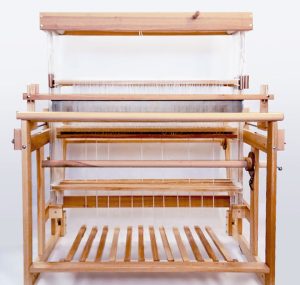Types of weaving machines and the history of weaving
Tari Podi fabrics are one of the fabrics that have been used for a long time. In this article, you will get to know the types of Tari Podi weaving machines and the history of weaving…

History of weaving
The textile industry is considered one of the oldest industries of human civilization, because after man’s need for food, clothing is the second basic need of man, which protects him from cold and heat and shows his social personality. According to the available evidence, mankind has been using woven fabric since nine thousand years ago, so the textile industry, especially weaving, has a very old history. For many centuries, the weaving industry has been considered the most important human production industry.In ancient times, man used tree branches, leaves and fodder to cover himself and by entwining them with each other, he succeeded in making the basic building of textiles. The above development continued until animal fibers such as wool, hair, silk and plant fibers such as hemp and cotton were widely used. With the advent of synthetic fibers, fabrics were prepared with different fineness and thicknesses and with very high flexibility. The explorations and researches of scientists and researchers in the last hundred years have shown that Iranians were one of the pioneers who worked on fabric weaving.Even the inhabitants of ancient Iran in the second Stone Age (or the so-called Stone Age) were familiar with weaving fabric. Professor Carlton Kenn, during his excavations in a cave known as the Belt Cave near the Caspian Sea (Bahshahr city), found fabrics that prove Iranian tribes have been weaving sheep and goat wool into cloth since the beginning of cave dwellings. The experiments conducted on these cloths showed that they date back to 6500 years BC. Among human handicrafts, the weaving industry is very old. Is.So that the products of this industry are not only for meeting human needs, but also have great importance in social, cultural and other issues. For a long time, hand looms were used to weave cloth, until in 1733, John Kay invented the method of throwing the fast maqui, causing the weaving process to be faster than before. In the early years of the 19th century, looms were made of cast iron and powered by steam. The production of fabric with large images and shapes has been another development in the weaving industry, which was created by Charles Marie Jacquard in 1809 with the invention of Jacquard opening.In order to increase the efficiency of knitting machines, the automatic bobbin changing system was installed on knitting machines in the late 19th century, and these machines are called automatic knitting machines. For the automation of weaving machines, many activities were carried out, including the thread and weft care mechanism, the bobbin feeding mechanism using the bobbin carrying box instead of the bobbin battery, and the bobbin winding mechanism in the loom. In order to increase the speed of weaving machines, in addition to the mentioned cases, it was tried to reduce the mass of the object thrown into the opening.To achieve this goal, wefting methods without mako (such as projectile, rapier, air jet and water jet) were invented. In wefting methods without mako, the mass of the projectile object has been greatly reduced and thus the production of weaving machines has increased significantly. Multi-slot looms were built to increase the power of wefting, and at a given time, several wefting objects could enter the opening at the same time. In other words, a loom could work by forming several working openings at the same time, and the power of wefting would increase several times. Increased.Tari and weft textiles have advantages such as stability and resistance to deformation due to compression and tensile stress, and these features distinguish tari and weft fabrics from cheaper circular textiles and non-woven textiles.
Knitting machines
Different methods are used to produce fabric. One of these methods is tari-poodi weaving. At least two sets of threads are used in the warp and weft weaving method. The first category is the warp threads that are placed in the direction of the length of the fabric, and the second category is the weft threads that are placed in the direction of the width of the fabric. The warp and weft threads are perpendicular to each other, and the texture surface is created by weaving them. To carry out fabric weaving operations, it is necessary to divide the warp threads into two groups so that one group is placed at the top and the other group is at the bottom.In this way, an opening is created for the passage of the weft thread, and after the weft thread is placed in the opening, the operation of hitting the weft thread on the edge of the fabric is performed. It should be noted that for the production of some textiles (such as machine-made carpets, towels, and velvets), more than one strand of yarn or weft is used, and they are made of wood.

Hand knitting machine:
This type of weaving machine is usually made of wood. In figure 1, you can see the hand knitting machine.
Components of hand knitting machine
Machine chassis: The machine chassis is the primary skeleton of a weaving machine and the components of the weaving machine are placed on the chassis.
Snowy Tar: The warp threads are twisted together on a special roller in a special order and according to the designer’s opinion. which is known as Snowy Tar.
Forming the opening: To make the weave, it is necessary to divide the threads into two groups. One group is at the top and the other group is at the bottom. The top and bottom of each word is done according to the plan that has been prepared in advance. The threads are passed through the opening of the milking machine and as a result of the up and down of the wards (the frame and milking machine) and the formation of the opening, wefting is done.
The machines are different in terms of the number of warps. The simplest machine has two warps and can only weave taffeta fabric. Usually hand knitting machine has 4 or 8 rows. In Figure 2, you can see how to move the words. In one of the machines, the gears are done by pressing the pedal, but in the lower machine, the gears are moved by moving the lever.
Wefting: wefting means placing the weft thread in the opening created. Weaving in these machines is done by Mako. For this purpose, they first put the spool of thread (bobbin) inside the mako and find the thread end. Weaving is done by taking the cue and moving the mako in the hole.
Daftin: Daftin is used to press the weft thread to the edge of the fabric. Daftin includes a comb with wooden or metal teeth. The shoulder can be separated from the pocket and another shoulder can be placed in it. The number of threads that pass through each tooth of the comb is important. The number of comb teeth in one meter is used as the measuring unit of the comb.
Fabric twisting: By increasing the amount of fabric texture, it is wrapped around a special roller called fabric twisting roller. It is obvious that if it is twisted too much, there will be a gap between the wefts, and if the twist is too low, the wefts will overlap. Therefore, the twisting speed of the fabric is very important.
Electric knitting machine
With the invention of electric motors and its use in weaving machines, the speed of fabric weaving increased and as a result fabric production was done at a faster rate. Electric motors have rotary motion, while the Mako launch requires an impact force. On the other hand, the texture of the fabric is weft to weft and the twist of the fabric should be very relaxed. Now, the speed of the engines is about 200-400 revolutions per minute (RPM). The solution to the problem is in the use of gears, wheels and usually chains, wheels and belts.
In the picture below, you can see a knitting machine with an electric motor.
Weaving in these machines is done with mako and the speed of weaving is much higher; Therefore, the speed of fabric weaving increases. These machines have the following advantages compared to manual weaving.
Higher texture speed
Increase uniformity in texture
Reducing the manpower required for fabric weaving
Wider width of woven fabrics than before
The disadvantages of these machines compared to hand weaving are:
A lot of noise
Dangers of electrocution
Dangers caused by throwing the mako and hitting the user’s body and tearing the threads
Automatic knitting machines
One of the fundamental developments in the weaving industry has been the construction of fully automatic weaving machines. These machines are completely intelligent and can work according to a predetermined plan and map. In figure 5, you can see an example of an automatic machine.

Weaving cycle in knitting machines:
A special operation is necessary for weaving a fabric. This operation is called tissue cycle and consists of:
Formation of mouth (up and down of the words)
Wefting (placing the weft thread inside the opening)
Sewing and pressing the weft thread to the edge of the fabric
Opening the warp yarn to the required size (related to the density of the fabric)
twisting the fabric roller to the required extent (related to the density of the fabric)
Control and care of warp thread and weft thread
This operation is repeated for each weave. For this reason, it is called the weaving cycle. For the weave of 10 wefts, the above operations will be repeated ten times.
In automatic machines, control in wefting and determining and correcting the tension of warp threads has also been added to it.
final word
Arachap Rangin Sepahan company is in the field of reactive digital printing on taripodi fabrics and other natural fiber fabrics and is ready to cooperate with companies, start-ups, brands, fashion houses, etc. This company competes not only with domestic companies but also with other countries with the technical knowledge and technology of the world. Click to get a free consultation


